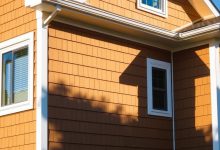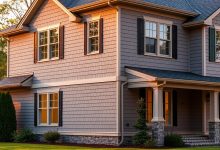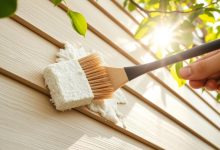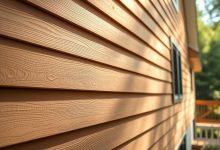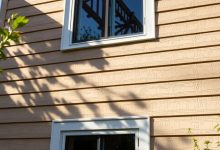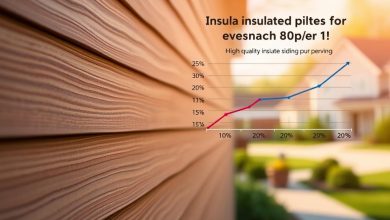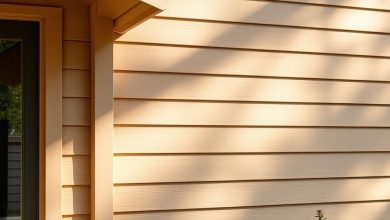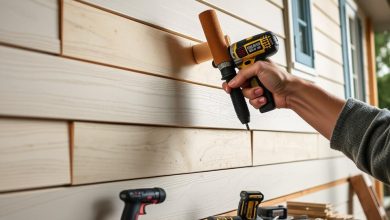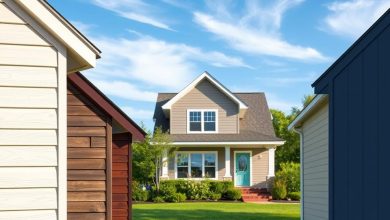Insulated Siding: Quiet Your Home and Block Noise
A quiet home is a haven, but noise pollution can disrupt the peace. Insulated siding is a solution that can help you achieve a quieter living environment.
Noise reduction siding is designed to block out unwanted sounds, creating a more serene atmosphere. By installing insulated siding, homeowners can enjoy a more peaceful home life.
Key Takeaways
- Insulated siding helps reduce noise pollution.
- Noise reduction siding creates a more serene atmosphere.
- Quiet home solutions improve overall living experience.
- Insulated siding is a practical solution for homeowners.
- A quieter home enhances overall well-being.
Understanding Noise Pollution in Residential Areas
Residential areas face growing noise pollution from outside. This pollution is a big environmental stress. It can harm health and lower quality of life.
Common Sources of External Noise
There are many types of external noise. The main ones include:
Traffic and Transportation Noise
Highways, roads, and airports are big noise polluters. Cars and trucks, mainly during busy times, make a lot of noise.
Neighborhood and Construction Sounds
Construction, lawn mowers, and loud parties also add to the noise. These sounds are common in neighborhoods.
How Noise Affects Health and Well-being
Noise pollution is more than just a bother. It can seriously harm health.
Sleep Disruption and Stress
One big problem is sleep disruption. Too much noise can cause stress and sleep problems.
Productivity and Quality of Life Impacts
Noise pollution also hurts productivity and life quality. It can make you less focused, more irritable, and unhappy.
| Noise Source | Average Noise Level (dB) | Health Impact |
|---|---|---|
| Traffic Noise | 80-90 | Stress, Sleep Disturbance |
| Construction Noise | 90-100 | Hearing Loss, Stress |
| Neighborhood Noise | 70-80 | Annoyance, Sleep Disturbance |
What Is Insulated Siding and How Does It Work?
Insulated siding helps keep outside noise out. It’s a siding type that adds insulation. This makes homes more energy-efficient and quieter.
Definition and Basic Components
Insulated siding has a few main parts. These include the siding material, backing materials, and insulation.
Backing Materials and Insulation Types
Backing materials can be foam board or fiberglass. The insulation often used is rigid foam insulation or expanded polystyrene.
The Science Behind Sound Absorption
Sound absorption science is simple. It’s about using materials that soak up sound waves. This reduces noise inside homes.
Sound Wave Interruption
Insulated siding stops sound waves from getting in. It uses materials that absorb sound well.
Mass and Density Factors
The siding’s mass and density matter too. Denser materials absorb sound better. This makes homes quieter.
Insulated Siding for Noise Reduction: How Effective Is It?
Insulated siding is becoming more popular for its ability to cut down on noise. But how well does it really work? To understand its noise-cutting power, we need to look at its Sound Transmission Class (STC) ratings and how it performs in real life.
Sound Transmission Class (STC) Ratings Explained
The STC rating shows how well a material or assembly blocks sound. It’s key to know how STC ratings work to see if insulated siding really cuts down on noise.
Interpreting STC Numbers
STC ratings go from 0 to 100. A higher number means better sound blocking. For example, a wall with an STC of 50 blocks sound well. But a rating under 30 means it doesn’t block sound much. Knowing these numbers helps homeowners pick the right siding.
Real-world Noise Reduction Results
While STC ratings give a theoretical idea of sound blocking, real results can differ. It’s important to look at both STC ratings and how well insulated siding works in practice.
Decibel Reduction Expectations
In real life, insulated siding can greatly reduce outside noise. For instance, a well-done insulated siding job can cut down noise by 10 to 20 decibels. This makes a big difference in how quiet your home feels.
Factors Affecting Performance
Many things can change how well insulated siding blocks noise. These include the quality of the installation, the siding material, and any gaps or cracks. Getting the installation right and keeping it up is key to getting the best noise reduction.
Types of Insulated Siding Materials
Homeowners have many options for insulated siding. Each material has its own benefits and features. The right choice depends on climate, budget, and personal taste.
Vinyl Insulated Siding
Vinyl insulated siding is a favorite for many. It’s affordable and easy to maintain. It has insulation sandwiched between two vinyl layers.
Foam-Backed Vinyl Options
Foam-backed vinyl siding adds foam insulation to the back of vinyl. This boosts thermal performance and sound insulation.
Fiber Cement Insulated Options
Fiber cement siding is made from cement, sand, and cellulose fibers. It’s durable and resistant to pests and weathering.
Composite Insulation Systems
Some fiber cement siding has composite insulation. This mix of materials improves energy efficiency and noise reduction.
Wood-based Insulated Products
Wood-based siding is a natural and eco-friendly choice. It comes in solid wood and engineered wood forms.
Engineered Wood with Built-in Insulation
Engineered wood siding with insulation is a modern option. It combines wood’s charm with insulation’s benefits. This siding offers improved thermal performance and reduces noise pollution.
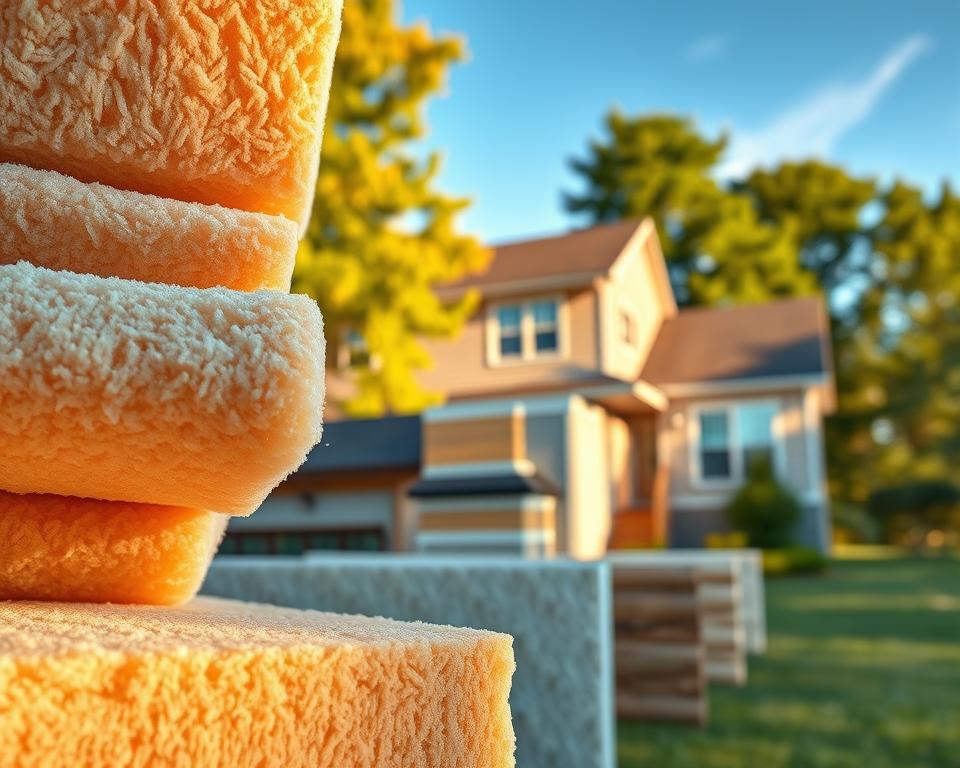
Top Insulated Siding Brands for Noise Control
Looking for a quieter home has led to new insulated siding products. Many top brands are known for their quality and how well they work. They help make homes quieter.
CertainTeed’s Noise-Reducing Product Line
CertainTeed is a big name in siding, known for its noise-reducing products. Their siding is made with special materials. These materials keep homes warm and block out noise.
Homeowners love CertainTeed for its quality and new ideas. It’s a top pick for those who want less noise.
James Hardie Insulated Options
James Hardie also focuses on making homes quieter. Their siding is made from fiber cement. It’s strong and helps block sound.
James Hardie’s siding keeps homes quiet and protects against weather and pests. It’s a great choice for a quieter home.
Mastic’s Sound-Dampening Solutions
Mastic has insulated siding that blocks out noise. Their products are made to keep homes peaceful. They’re also durable and easy to care for.
ProVia’s Insulated Siding Systems
ProVia makes high-quality building products, including insulated siding. Their siding is made with the latest technology. It blocks sound and saves energy.
ProVia’s siding is perfect for those who want a more comfortable home. It adds value and comfort.
Additional Benefits Beyond Noise Reduction
Insulated siding does more than just block out noise. It makes a home better in many ways. It improves the quality and function of a house.
Energy Efficiency and Cost Savings
Insulated siding helps a home use less energy. It keeps the house warm in winter and cool in summer. This means lower energy bills for you.
R-Value Improvements
The R-value shows how well a material keeps heat out. Insulated siding boosts a home’s R-value. This makes your home more comfortable and saves money on energy.
Impact Resistance and Durability
Insulated siding is tough and lasts long. It can handle bad weather and damage from impacts.
Weather and Pest Protection
This siding keeps your home safe from harsh weather and pests. It means you won’t have to fix things as often. This saves you money over time.
Aesthetic Improvements
Insulated siding comes in many styles and colors. This lets homeowners make their house look better.
Design Options and Curb Appeal
There are many design options to choose from. You can pick a style that fits your home’s look. This can make your home look better and even increase its value.
| Benefit | Description | Advantage |
|---|---|---|
| Energy Efficiency | Improves R-value, reducing heat loss and gain | Lower energy bills |
| Impact Resistance | Withstands weather conditions and impact damage | Long-term durability |
| Aesthetic Improvements | Available in various styles and colors | Enhanced curb appeal |
Comparing Insulated Siding to Other Noise Reduction Solutions
Insulated siding is great for cutting down on noise. But, it’s good to see how it stacks up against other options.
There are many ways to fight noise pollution. Each has its own good and bad points. Knowing these can help homeowners choose wisely.
Traditional Siding with Separate Insulation
Traditional siding can be paired with insulation to block some noise. But, it’s not as good as insulated siding. That’s because insulated siding is a complete system.
Soundproofing Windows and Doors
Soundproofing windows and doors is key for quieter homes. Yet, it might cost more and be harder to set up.
Interior Soundproofing Methods
Adding insulation to walls or using sound-absorbing materials can help. But, they might not work as well in very loud places.
Landscape Barriers for Noise Control
Fences or landscaping can block some noise. But, how well they work depends on the barrier and the noise source.
To compare these options, here’s a quick table:
| Noise Reduction Solution | Effectiveness | Cost | Complexity |
|---|---|---|---|
| Insulated Siding | High | Moderate | Medium |
| Traditional Siding with Separate Insulation | Medium | High | High |
| Soundproofing Windows and Doors | High | High | High |
| Interior Soundproofing Methods | Medium | Moderate | Medium |
| Landscape Barriers | Low to Medium | Low to Moderate | Low to Medium |
Installation Process for Insulated Siding
To get the most out of insulated siding, it’s important to install it right. The process has key steps that affect how well it works.
Preparation Requirements
Before starting, homeowners need to check their home’s condition. This means:
- Looking for any damage or rot on the exterior walls
- Removing old siding, if needed
- Measuring carefully to fit the siding perfectly
Home Assessment and Measurements
It’s important to assess your home well before installing. Getting the measurements right helps avoid waste and makes the job smoother.
Professional vs. DIY Installation
Homeowners can choose to install it themselves or hire a pro. While DIY saves money, hiring a pro has its benefits, like:
- Experts handle tricky jobs
- They offer warranties on work and materials
- It saves time for homeowners
Skills and Tools Required
If you’re doing it yourself, you’ll need the right skills and tools. This includes siding experience, safety gear, and tools like siding cutters and nail guns.
Timeline and Disruption Expectations
Knowing the timeline and any disruptions is key for planning. The time it takes depends on your home’s size and the job’s complexity.
Typical Project Duration
Installing insulated siding usually takes a few days to a few weeks. Homeowners should plan ahead and talk about the timeline with their installer.

Cost Analysis of Insulated Siding
Understanding the cost of insulated siding is key for homeowners. It’s about the upfront cost and the long-term benefits it offers.
Initial Investment Considerations
The cost of insulated siding includes material and labor. Material costs change based on the siding type, like vinyl, fiber cement, or wood.
Material and Labor Cost Breakdown
Materials usually make up 60-70% of the cost. Labor costs are 30-40%. For example, vinyl siding might cost $8 to $12 per square foot. Labor adds $4 to $6 per square foot.
Long-term Value and ROI
The initial cost of insulated siding is high. But, its long-term benefits and ROI are worth it. It saves energy by reducing heat loss in winter and heat gain in summer.
Energy Savings Calculations
Homeowners can save 10% to 30% on energy bills. Savings depend on insulation quality and local climate. For instance, a cold climate homeowner might save up to $300 on heating.
Financing Options and Tax Incentives
Insulated siding is more affordable with financing options and tax incentives. Homeowners can look into government loans or rebates from utility companies and manufacturers.
Available Rebates and Programs
Utility companies and government agencies offer rebates for energy-efficient upgrades, like insulated siding. Homeowners should check local and federal programs to save more.
Maintenance Requirements and Longevity
To keep your insulated siding in top shape, regular care is key. It keeps your home looking good and working well. This includes better soundproofing and saving energy.
Cleaning and Upkeep Best Practices
Cleaning your insulated siding is easy. Use a soft cloth or a soft-bristled brush to wipe away dirt and debris. For stubborn stains, mix mild soap with water. But stay away from harsh chemicals or rough cleaners that can harm the siding.
Seasonal Maintenance Tips
- Spring: Check for winter damage and clean off any debris.
- Summer: Look for wear and tear, and touch up or seal as needed.
- Fall: Clean off leaves and debris, and check for autumn damage.
- Winter: Make sure the siding is securely fastened to handle cold weather and snow.
Expected Lifespan of Different Materials
The life span of insulated siding depends on the material. Vinyl insulated siding can last up to 30 years or more with good care. Fiber cement insulated siding is very durable and can last 30 to 50 years. Wood-based insulated products need more upkeep and usually last 20 to 40 years.
Warranty Considerations
When picking insulated siding, think about the warranty. A good warranty gives you peace of mind and protects your investment. Look for warranties that cover both materials and labor for a long time.
Case Studies: Homeowners’ Experiences with Noise-Reducing Siding
Homeowners in cities and suburbs are enjoying quieter homes thanks to noise-reducing siding. Real-life examples show how well insulated siding works.
Urban Home Transformation
In a busy city, a homeowner chose insulated siding. This choice greatly cut down on outside noise. The before and after sound measurements were impressive, proving the siding’s success.
Before and After Sound Measurements
Before the siding, the home’s sound level was 65 decibels. After, it fell to 45 decibels. This is a 20 decibel drop, making the home much quieter.
Suburban Traffic Noise Solutions
In suburbs, traffic noise is a big problem. Homeowners with insulated siding say they hear less traffic. Their stories show how much better their lives are now.
Homeowner Satisfaction Reports
“The noise reduction is amazing. We don’t hear the traffic hum anymore,” said one homeowner. These stories prove insulated siding works well in suburbs.
Challenging Noise Environment Solutions
Homes near airports or highways face special noise issues. Insulated siding is a great solution. Case studies from these areas show big noise cuts.
Airport and Highway Proximity Cases
A homeowner near a major highway saw a big noise drop after getting insulated siding. “It feels like we’re in a different house,” they said, showing the siding’s big impact.
“The installation of noise-reducing siding has been a game-changer for our home. The difference is palpable.” – Homeowner near an airport
These stories show insulated siding’s power to cut noise in many places. Whether in cities, suburbs, or noisy areas, homes are quieter and more peaceful.
Conclusion: Creating Your Quieter Home Environment
Insulated siding is a great way to cut down on noise and make your home quieter. It helps you understand the benefits and how it works. This way, you can choose the right siding for your home.
There are many types of insulated siding, like vinyl, fiber cement, and wood. Brands like CertainTeed, James Hardie, and ProVia offer top-notch options. These not only reduce noise but also save energy, withstand impacts, and look great.
Getting insulated siding can make your home quieter and more comfortable. It can even increase your home’s value. Studies show it works well in cities and suburbs alike.
If you want a quieter home, look into insulated siding. Talk to experts to find the best fit for your home.

